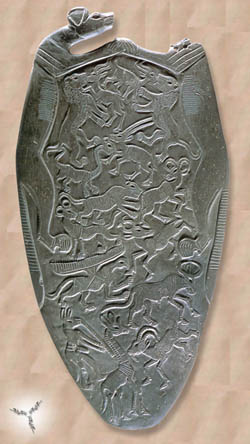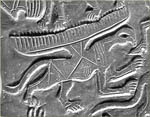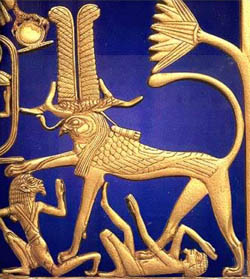

The Gryphon:Legend and Myth
© SunBlind 2007
Please do not use this text without my permission. [see footnote below]
If you find any errors or omission, please drop me a note to let me know!




It is unknown how the legend of the gryphon made it's way here from Mesopotamia. First seen in the Predynatic period (5,500 - 3,100 B.C.). One of the first depictions is the "Two Dog Palette" found at Hierakonopoli in Upper Egypt. On the back of the palette one finds the gryphon, near the middle on the left. Below you can see it on it's own.

I cannot be denied that the world outside the relative safety of the Nile valley must have appeared to be a strange and dangerous place, filled with strange creatures, such as the gryphon. They were generally depicted as having a falcon's head and were not always winged.
While most mythical beasts disappeared in the Old Kingdom (2650-2575 B.C.), the gryphon survived, becoming a symbol of a victorious ruler and occasionally appared on royal monuments. The gryphon also appears in the Chamber of the Seasons in Niuserre, a 5th Dynasty solar temple at Abu Ghurab.
By the Middle Kingdom (1986 - 1759 B.C.), mythical creatures once more abound, the gryphon among them. In the 11th Dynasty tomb of Baket III at Beni Hasan, the gryphon makes another appearance along with other mythical and real creatures. Also at Beni Hasan, in the tomb of Baquet III the hunt for several mythical creatures, including the gryphon, is depicted. At another tomb at Beni Hasan, this of Khety, one finds a female gryphon wearing a collar and leash. At the nearby site of Deir el-Bersha a gryphon follows a troop of four pet monkeys. In both cases it appears that the gryphon was considered to be a pet. It has been suggested that the gryphon (or saget as they were refered to in these images) were actually dogs dressed up as the mythical beast, perhaps to transform the dogs into the legendary hunter. Or maybe it was considered to be a prestigious possession. In the tomb of Khnumhotep II, the gryphon is shown with V-shaped wings, a slender speckled body and a longer neck than usual. We don't see this type of gryphon again later on.
Over time it became to be considered to be the mightiest of all animals. The gryphon sometimes appears as an representation of the war go Montu, though it is wingless. One name used for the gryphon was "one who tears to pieces", used in the Coffin Texts and in Bersheh. This gryphon had a feathered crown. The gryphon also appears in hieroglyphs.
 In the New Kingdom (1539 - 1069 B.C.), the gryphon appears more frequently, though now it is a more slender beast with the head of a vulture or eagle, rather than that of a falcon. To display royal power the king could be depicted in the form of a huge gryphon trampling his enemies underfoot.
In the New Kingdom (1539 - 1069 B.C.), the gryphon appears more frequently, though now it is a more slender beast with the head of a vulture or eagle, rather than that of a falcon. To display royal power the king could be depicted in the form of a huge gryphon trampling his enemies underfoot.
In the Late New Kingdom (664 - 332 B.C.), gryphons were believed to pull the chariot of the god Shed, whose task it was to kill dangerous desert animals using his bow and arrow. This type of gryphon was called "the swift one".
In the Ptolemaic period, it was associated with retributive justice. Finally, in the Greco-Roman Period, there exists a tale called Inaros and the Griffin about the battle against a giant gryphon from the Red Sea.
More info:
 Ancient Egypt Magazine - Vol. 3 Issue 3 Ancient Egypt Magazine - Vol. 3 Issue 3
 Strange (Fantastic) Animals of Ancient Egypt Strange (Fantastic) Animals of Ancient Egypt


Footnote I just want to clear up when you actually need my permission to use this information. What I generally don't want is for you to simply copy this page and stick it up on your own website without asking me first, especially if you claim to have written it yourself. If you are using it for a school project, that's fine, you don't need to ask me first. Depending on your grade level, you'll know how your teacher wants you to reference the information to avoid plagirism.


| 






